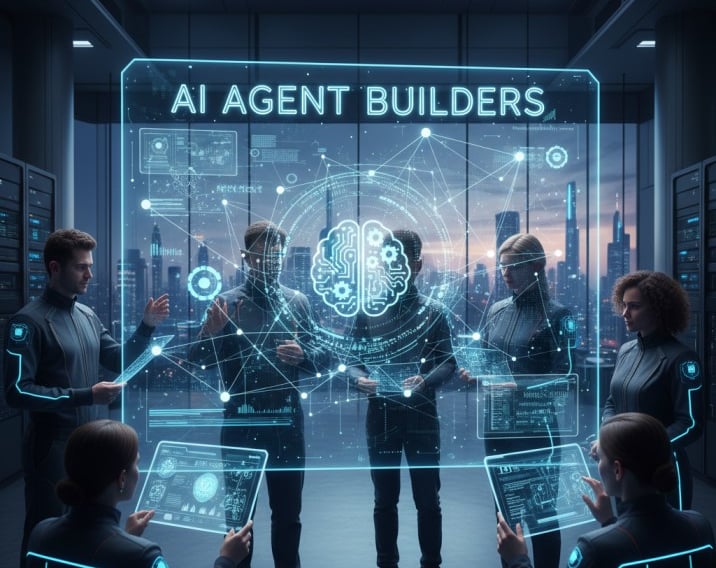Build Your Autonomous Future: The Ultimate Guide to AI Agent Builders
In the swiftly evolving landscape of artificial intelligence, a new tool is revolutionizing how businesses automate complex, multi-step workflows: the AI Agent Builder. Forget basic chatbots that only answer simple questions. AI Agents are autonomous systems that can reason, plan, execute tasks across different tools, and even learn from their interactions—all aimed at achieving a specific, high-level goal.
11/5/20253 min read


What Exactly is an AI Agent Builder?
An AI agent builder is a specialized, self-service development platform that allows individuals and businesses to design, configure, and deploy sophisticated AI agents with minimal to zero coding.
Think of it as a comprehensive toolkit for building an intelligent, autonomous employee. These platforms abstract away the complexities of the underlying machine learning models (like large language models or LLMs) and provide a user-friendly, often visual, interface (like drag-and-drop workflow builders) to define the agent's purpose, rules, tools, and memory.
Instead of writing thousands of lines of code to integrate APIs and manage complex logic, an AI Agent Builder lets you map out the agent's thought process and actions in a visual way, dramatically accelerating your time to value from AI investments.
A truly robust AI agent isn't just a fancy chatbot—it's a system with several integrated components that allow it to act autonomously. When evaluating an AI agent builder, look for the following key features:
1. The Core: LLM and Reasoning Engine
The large language model (LLM), such as models from Gemini, GPT, or others, serves as the agent's brain. The builder platform should provide:
· Model Agnosticism: The ability to choose or switch between the best-performing LLMs for your task.
· Prompt Customization: Advanced tools to fine-tune the system prompts that govern the agent's behavior, ensuring its responses are accurate, on-brand, and aligned with your specific goals.
· Planning and Task Breakdown: A module that enables the agent to take a high-level goal (e.g., "Onboard a new client") and break it down into a logical sequence of smaller, manageable steps (e.g., "Send welcome email," "Create user account," "Schedule kickoff call").
2. The Tools: Integration and Action
An agent cannot act autonomously without the ability to interact with the real world.
· API and Connector Registry: Easy, pre-built, and secure connectors to your existing business tools (e.g., CRM like Salesforce, email platforms, databases, marketing automation software). The agent must be able to securely call these APIs to perform actions like sending an email or updating a record.
· Tool Use/Function Calling: The crucial ability for the agent to decide which tool to use and when to use it to complete a step in its plan.
3. The Context: Memory and Data
For an agent to be effective, it must remember past interactions and have access to up-to-date, relevant company data.
· Short-Term (Conversational) Memory: Retains context within a single interaction or thread, so the agent doesn't "forget" what was just discussed.
· Long-Term (Retrieval-Augmented Generation/RAG) Memory: Securely connects the agent to your proprietary knowledge base (documents, PDFs, databases). This grounds the agent's responses in your company's 'single source of truth,' preventing hallucinations and ensuring accurate, business-specific output.
4. The Guardrails: Security and Governance
Autonomy requires control. Enterprise-grade AI agent builders must include:
· Policy-as-Code: The ability to define and enforce rules (guardrails) that limit the agent's actions and ensure compliance (e.g., "Never disclose PII," "Require human approval before deleting a customer record").
· Observability and Auditing: Dashboards and logging to trace every decision and action the agent takes, allowing you to debug, audit, and measure its performance and cost..


Use Cases: Where Can AI Agents Make the Biggest Impact?
The versatility of a well-built AI agent means its potential is virtually limitless. Here are a few high-impact use cases:
· Customer Support & Service: An agent can resolve multi-step customer issues by querying internal systems, generating a solution, creating a personalized follow-up email, and logging the complete interaction in the CRM.
· Sales & Lead Enrichment: An agent takes a raw lead from a form, cross-references it with a third-party data provider (tool use), updates the lead score and account owner in the CRM, and schedules the first outreach task for the sales rep (action).
· HR Onboarding/Offboarding: An agent coordinates the entire process: creating system accounts (IT API), sending welcome documents (email tool), notifying the manager, and scheduling the first week's training sessions (calendar tool).
· Marketing Content Automation: An SEO agent can analyze SERP data for a target keyword, generate a content brief with suggested H2s and data points (research), and even draft a first-pass outline, all automatically.
Your Future is Autonomous -
The rise of the AI Agent Builder is a defining moment for enterprise automation. It is the key to creating an autonomous workforce that handles the repetitive, multi-step, and context-dependent tasks that slow down your human teams. By choosing a powerful, feature-rich, and secure no-code platform, you don't just invest in a tool—you invest in a future where innovation is faster, productivity is higher, and your business is truly intelligent.
Faceless Videos
© 2024. All rights reserved.
Photoreal 3D Walkthroughs
AI Video Tools
Text To Video
Image To Video
If you have any specific query regarding video making , lets connect .
Lifetime Deals
Realestate
Video Marketing
Lumalabs
KlingAI
